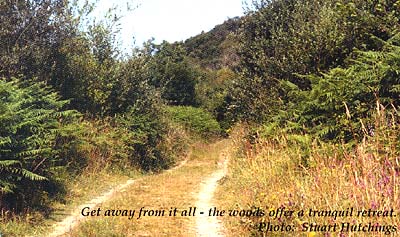Escape to the wild woods
After the frantic activity of spring, high summer can seem a relatively quiet time in a woodland. Birds that until recently seemed to go out of their way to attract attention with noisy song and display flights now seem to have disappeared, melting away into the vigorous growth of summer to quietly moult, replacing feathers worn out by the demands of raising a family. Although there are still many plants in flower, the large showy displays put on by such vigorous woodland carpeters as lesser celandine, wood anemone and of course bluebell are long since over. However, a walk around the Trust's nature reserve at Cabilla and Redrice Woods at this time of year will still reward the visitor with a wealth of wildlife.
Whilst the birds may have withdrawn somewhat from the main stage, with the song of most species stopping as the season wears on, their absence is more than compensated for by the presence of vast numbers of insects, the beating of millions of tiny wings making up the "summer hum" so characteristic of hot sunny days. Most obvious amongst these aerial performers are the butterflies and dragonflies, and of the former the undisputed stars at Cabilla and Redrice are undoubtedly the fritillaries. Walk through a sunny clearing or glade in June or early July and you may be lucky enough to spot a small pearl-bordered fritillary. One of Britain's smallest fritillaries, it occurs in damp, open, deciduous woodlands that have a continuous history of coppice or underwood management that encourages the growth of violets, its larval food plant. A tawny brown butterfly with black veins, numerous black spots and a dark band around the margins, the small pearl-bordered fritillary has declined rapidly in recent years, corresponding with the decline in traditional forms of woodland management.
From July to early September another, more obvious, fritillary is on the wing - the magnificent silver-washed fritillary. This large, deep orange butterfly, with rows of black spots on the upper side, is a strong flier and much more mobile than other fritillaries. It can often be seen at Cabilla gliding high along open sunny rides searching

for nectar-giving plants such as bramble and thistles; as with the small pearl-bordered, the caterpillars feed on violets.
Along with numerous other species of butterflies at Cabilla, the most visible insects at this time of year are the dragonflies and their cousins the damselflies. Large hawker dragonflies patrol open sunny rides, whilst around areas of still, open water look out for the broad-bodied chaser and the smaller red common darter. As the footpath nears the river, groups of the aptly named beautiful demoiselle bask on bramble patches in full sun, their metallic green bodies reflecting the light. The presence of this highly pollution-sensitive species is a sure sign of the health of the river.
Although the insects described above are the most visible, a little time spent by the more patient visitor will be rewarded with sightings of other species: bees,
bugs, beetles, spiders and wasps including the hornet (our largest wasp). Proceed quietly and you may spot other animals: an adder, grass snake, slow-worm or common lizard basking in the sun, or maybe a glimpse of roe or red deer.
So if you're bored with the beach or can't face that trip to the shops, why not escape for a while with a visit to the wild woods? You never know, you might just see something ...
Steve Chudleigh
Directions: From the A38, 5km (3 miles) east of Bodmin,. take the turning north towards Cardinham (next to White Lodge). Cross the bridge over the River Fowey, and access is via a track on the right past the sawmill (SX 129 652)